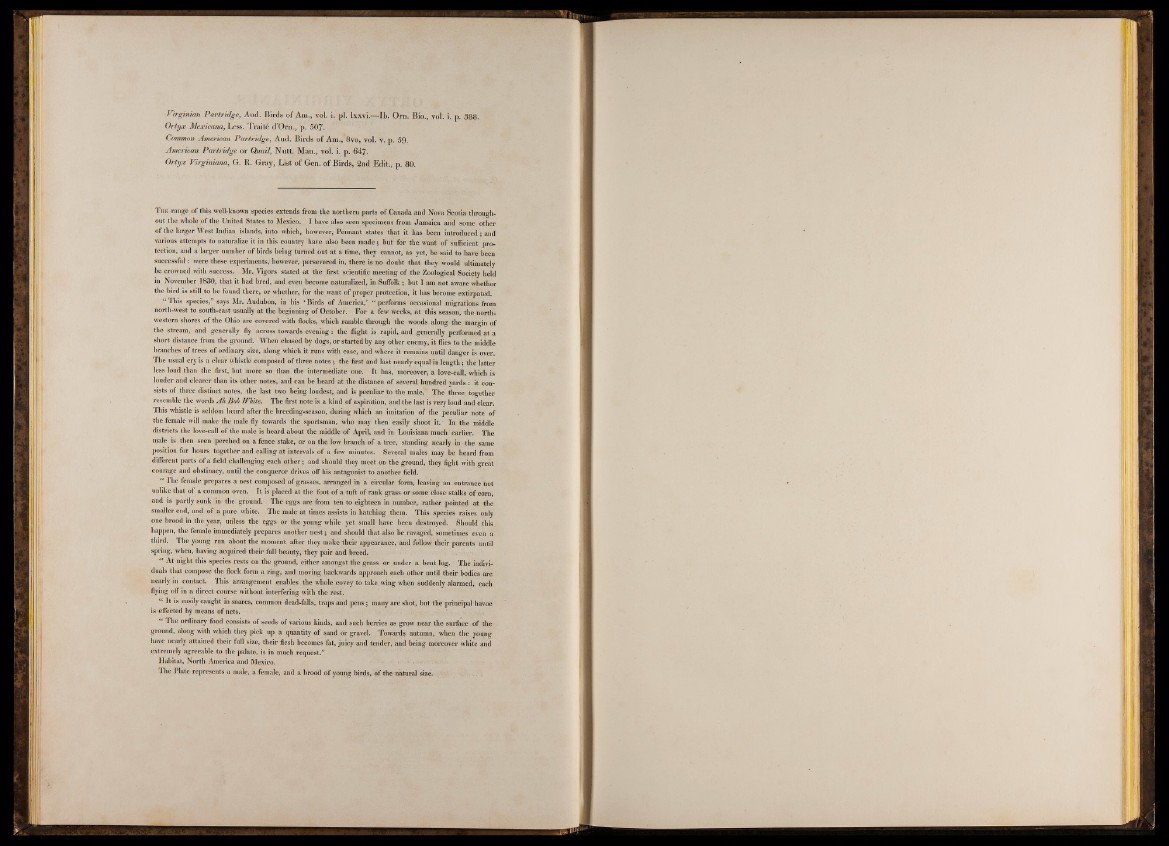
Virginian Partridge, And. Birds o f Am., vol. i. pi. lxxvi.MIb. Orn. Bio., vol. i. p. 388.
O rty x Mexicana, Less. Traité d’Orn., p. 507.
Common American Partridge , Aud. Birds o f Am., 8vo, vol. v. p. 59.
American Partridge or Quail, Nutt. Man., vol. i. p. 647-
O rty x Virginiana, G. R. Gray, List o f Gen. o f Birds, 2nd Edit., p. 80.
T he range of this well-known species extends from the northern parts of Canada and Nova Scotia throughout
the whole of the United States to Mexico. I have also seen specimens from Jamaica and some other
of the larger West Indian islands, into which, however, Pennant states that it has been introduced; and
various attempts to naturalize it in this country have also been made ; but for the want of sufficient protection,
and a larger number of birds being turned out at a time, they cannot, as yet, be said to have been
successful : were these experiments, however, persevered in, there is no doubt that they would ultimately
be crowned with success. Mr. Vigors stated at the first scientific meeting of the Zoological Society held
in November 1830, that it had bred, and even become naturalized, in Suffolk ; but I am not aware whether
the bird is still to be found there, or whether, for the want of proper protection, it has become extirpated.
“ This species,” says Mr. Audubon, in his ‘Birds of America,’ “ performs occasional migrations from
north-west to south-east usually at the beginning of October. For a few weeks, at this season, the northwestern
shores of the Ohio are covered with flocks, which ramble through the woods along the margin of
the stream, and generally fly across towards evening : the flight is rapid, and generally performed at a
short distance from the ground. When chased by dogs, or started by any other enemy, it flies to the middle
branches of trees of ordinary size, along which it runs with ease, and where it remains until danger is over.
The usual cry is a clear whistle composed of three notes ; the first and last nearly equal in length ; thé latter
less loud than the first, but more so than the intermediate one. It has, moreover, a love-call, which is
louder and clearer than its other notes, and can be heard at the distance of several hundred yards : it consists
of three distinct notes, the last two being loudest, and is peculiar to the male. The three together
resemble the words Ah Bob White. The first note is a kind of aspiration, and the last is very loud and clear.
This whistle is seldom heard after the breeding-season, during which an imitation of the peculiar note of
the female will make the male fly towards the sportsman, who may then easily shoot it. In the middle
districts the love-call of the male is heard about the middle of April, and in Louisiana much earlier. The
male is then seen perched on a fence stake, or on the low branch of a tree, standing nearly in • the same
position for hours together and calling at intervals of a few minutes. Several males may be heard from
different parts of a field challenging each other ; and should they meet on the ground, they fight with great
courage and obstinacy, until the conqueror drives off his antagonist to another field.
“ The female prepares a nest composed of grasses, arranged in a circular form, leaving an entrance not
unlike that of a common oven. It is placed at the foot of a tuft of rank grass or some close stalks of corn,
and is partly sunk in the ground. The eggs are from ten to eighteen in number, rather pointed at the
smaller end, and of a pure white. The male at times assists in hatching them. This species raises only
one brood in the year, unless the eggs or the young while yet small have been destroyed. Should this
happen, the female immediately prepares another nest ; and should that also be ravaged, sometimes even a
third. The young run about the moment after they make their appearance, and follow their parents until
spring, when, having acquired their full beauty, they pair and breed.
“ At night this species rests on the ground, either amongst the grass or under a bent log. The individuals
that compose the flock form a ring, and moving backwards approach each other until their bodies are
nearly in contact. This arrangement enables the whole covey to take wing when suddenly alarmed, each
flying off in a direct course without interfering with the rest.
“ It is easily caught in snares, common dead-falls, traps and pens ; many are shot; but the principal havoc
is effected by means of nets.
“ The ordinary food consists of seeds of various kinds, and such berries as grow near the surface of the
ground, along with which they pick up a quantity of sand or gravel. Toward^ autumn, when the. young
have nearly attained their full size, their flesh becomes fat, juicy and tender, and being moreover white and
extremely agreeable to the palate, is in much request.”
Habitat, North America and Mexico. • • • •',• t->: ‘ .
The Plate represents a male, a female, and a brood of young birds, of the natural size.